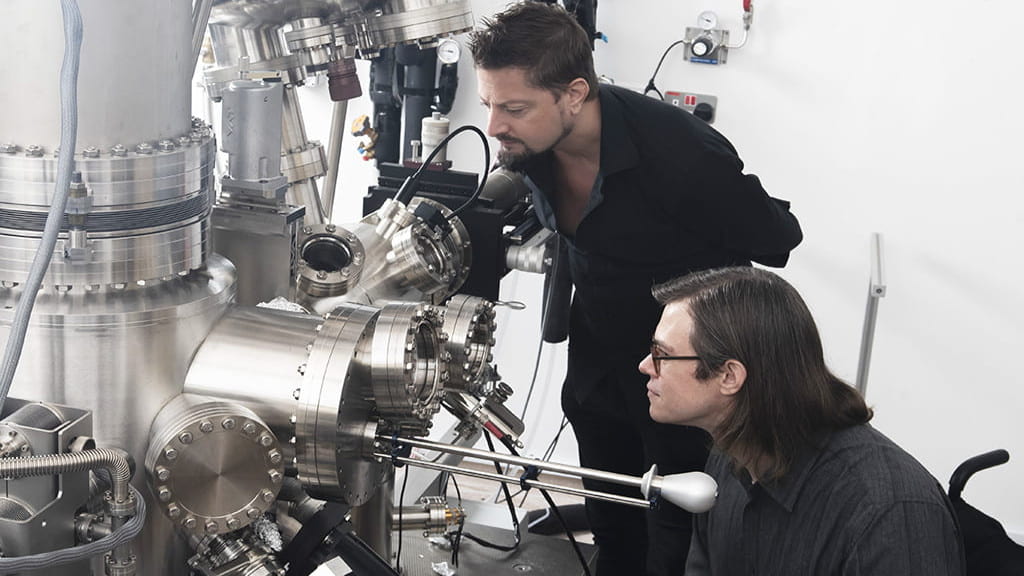Atomically thin materials known as quantum spin Hall insulators have unusual properties that can be used to create error-resistant quantum computers. Nanyang Assistant Professor Bent Weber and Dr Michael Lodge survey the development of this exciting research field.

(From left) Nanyang Assistant Professor Bent Weber and Dr Michael S. Lodge in the “Quantum Spin Hall lab”. Photo credit: M. Fadly
Quantum spin Hall insulators (QSHIs) are exotic forms of matter that act as electrical insulators within their interior, but allow electrons to flow along their edges. They are examples of materials called topological quantum materials, so-named because their behaviour stems from a combination of quantum mechanics and the mathematical concept of “topology”.
A QSHI maintains its characteristic physical properties in spite of external disturbances or imperfections in manufacturing. These properties are sustained by a feature of the electrons’ quantum states known to mathematicians as topology, analogous to how a sheet of paper maintains two sides no matter how it is crumpled.
In a recent paper published in the journal Advanced Materials, an NTU-led team of scientists surveyed the exciting developments in the creation of QSHI materials and their use in future technologies such as quantum computing.
Electrons flowing along the edges of QSHIs have a special feature called helicity. This means that their internal rotation, or spin, depends on the direction in which the electrons are moving. This helicity allows QSHIs to be used in a new class of “spintronic” devices. Ordinary electronics is based on the flow of electric charge, in which the spin is unrelated to the direction of motion, whereas spintronics also makes use of the flow of spin. Physicists have long suspected that spintronic devices can be faster and more efficient than electronic ones, but have thus far been unable to find materials in which spin can flow reliably at ordinary room temperatures.
Thinner is Better
QSHIs were first realized almost two decades ago in 3D layered semiconductor devices known as heterostructures. However, heterostructures have a number of fundamental limitations: their topological features appear only when the chemical composition of the semiconductors is chosen in just the right way, and only within a very narrow window of electron energies accessible at ultra-cold temperatures.
In recent years, researchers have discovered new classes of QSHIs made from atomically thin crystals. These two-dimensional materials have numerous advantages over semiconductor heterostructures, and hold tremendous promise for future device applications. For one thing, the energy window in which their topological properties manifest is at least ten times larger, allowing for operation at higher temperatures.
Atomically thin QSHIs have been shown to retain their topological properties up to a temperature of 100K, and future advances may even bring this up to room temperature.

An atomically thin quantum spin Hall insulator is a 2D material, depicted here as a honeycomb lattice, with an insulating interior and spin-polarized edge states that flow in opposite directions (red and blue arrows). Figure credit: M. S. Lodge
A Springboard to Quantum Computing
Possibly the most exciting application of helical electrons lies in quantum computing. When a QSHI is cooled to extremely low temperatures, such that the material becomes a superconductor, the helical edge electrons can combine into unusual quantum particles called “Majorana fermions.” Owing to their topological origin, the Majorana fermions are strongly protected against external disturbances, making them robust carriers of quantum information.
Nanyang Assistant Professor Weber is actively involved in this area of research. His laboratory uses a variety of techniques to probe the quantum properties of electrons in atomically thin QSHIs at low temperatures, as well as experimenting with ways to convert QSHIs into various spintronic and electronic devices.
Majorana fermions may serve as the basis for topological quantum computers. Quantum computers are devices that use quantum phenomena to perform certain calculations much more quickly than any feasible classical computer. However, a long-standing problem with them is that quantum information is easily corrupted by interactions with the external world. Topological quantum computers can retain quantum information over much longer periods of time, which is necessary for performing large-scale quantum computations.
The realisation of Majorana-based topological quantum computers is one of the great technical challenges of our time, and these remarkable materials may have an important role of play in this story.

Prof. Weber’s laboratory is equipped with a growth facility for quantum spin Hall materials, combined with a sensitive scanning tunnelling microscope (shown), operating at extremely low temperature. Photo credit: M. Fadly.
